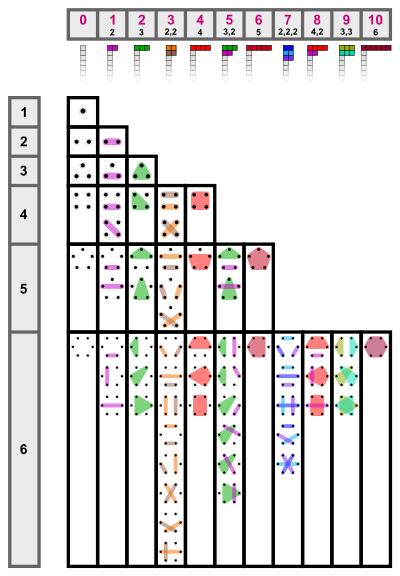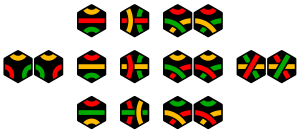Necklace (combinatorics)

corresponding to the k-th integer partition
(set partitions up to rotation and reflection)

Compare box(6,9) in the triangle.

Compare box(6,7) in the triangle.

In combinatorics, a k-ary necklace of length n is an equivalence class of n-character strings over an alphabet of size k, taking all rotations as equivalent. It represents a structure with n circularly connected beads of up to k different colors.
A k-ary bracelet, also referred to as a turnover (or free) necklace, is a necklace such that strings may also be equivalent under reflection. That is, given two strings, if each is the reverse of the other then they belong to the same equivalence class. For this reason, a necklace might also be called a fixed necklace to distinguish it from a turnover necklace.
Technically, one may classify a necklace as an orbit of the action of the cyclic group on n-character strings, and a bracelet as an orbit of the dihedral group's action.
Equivalence classes
Number of necklaces
There are
different k-ary necklaces of length n, where φ is the Euler's totient function.[1]
Number of bracelets
There are
different k-ary bracelets of length n, where Nk(n) is the number of k-ary necklaces of length n.
Examples
Necklace example
If there are n beads, all distinct, on a necklace joined at the ends, then the number of distinct orderings on the necklace, after allowing for rotations, is n!/n, for n > 0. This may also be expressed as (n − 1)!. This number is less than the general case, which lacks the requirement that each bead must be distinct.
An intuitive justification for this can be given. If there is a line of n distinct objects ("beads"), the number of combinations would be n!. If the ends are joined together, the number of combinations are divided by n, as it is possible to rotate the string of n beads into n positions.
Bracelet example
If there are n beads, all distinct, on a bracelet joined at the ends, then the number of distinct orderings on the bracelet, after allowing for rotations and reflection, is n!/(2n), for n > 2. Note that this number is less than the general case of Bn(n), which lacks the requirement that each bead must be distinct.
To explain this, one may begin with the count for a necklace. This number can be further divided by 2, because it is also possible to flip the bracelet over.
Aperiodic necklaces
An aperiodic necklace of length n is an equivalence class of size n, i.e., no two distinct rotations of a necklace from such class are equal.
According to Moreau's necklace-counting function, there are
different k-ary aperiodic necklaces of length n, where μ is the Möbius function.
Each aperiodic necklace contains a single Lyndon word so that Lyndon words form representatives of aperiodic necklaces.
Products of necklaces
The limit of the product of the numbers of fixed necklaces of length n composed of k types of beads:
 ,
,
where the coefficient of  in the expansion of the product
in the expansion of the product
presents the number of permutations of n with k inversions, expressed by a Mahonian number: A008302 (See Gaichenkov link)
See also
- Lyndon word
- Inversion (discrete mathematics)
- Necklace problem
- Necklace splitting problem
- Permutation
- Proofs of Fermat's little theorem#Proof by counting necklaces
- Forte number, a representation of binary bracelets of length 12 used in atonal music.



